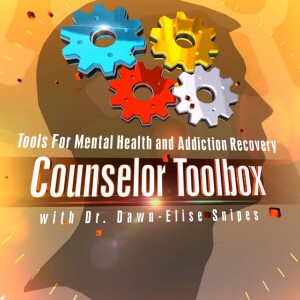
Counselor Toolbox Podcast with DocSnipes
Health & Fitness:Mental Health

985-Knowing What Does and Doesn't Work in CBT: Lessons for Counselors
 2024-07-04
2024-07-04
### Video Summary
**Title:** A Guide to Cognitive Behavioral Therapy for Counselors: What Works, What Doesn’t, and Why
**Presenter:** Dr. Dawn-Elise Snipes
**Link:** [Watch the video](https://youtu.be/tlR6T5jTCkM?si=Jjn2Wicv0EqvXJ-V)
---
#### Introduction
- Explanation of Cognitive Behavioral Therapy (CBT)
- Importance of CBT and its impact on thoughts, feelings, and behaviors
- Overview of the session's structure: what CBT is, what works, what doesn’t, and why
#### Understanding CBT
- CBT focuses on the interaction between thoughts, feelings, and behaviors
- Cognitive schemas: mental shortcuts based on past experiences
- Importance of checking and updating schemas as they may not always be accurate
#### Effects of Stress on the Brain
- Persistent stress impacts brain structure and function
- Weakens the vagus nerve, which affects the body's relaxation response
- Causes changes in the nervous system, impacting sleep and circadian rhythms
#### What Doesn’t Work in CBT
- Jumping into cognitive processing without establishing rapport, safety, and empowerment
- Aggressive confrontation of beliefs and behaviors
- Failing to address all three points of the CBT triangle: thoughts, feelings, and behaviors
- Telling instead of exploring, using mechanistic approaches, and not individualizing therapy
- Forcing new beliefs or schemas that the client doesn’t believe
#### What Works in CBT
- Educating clients about the connection between feelings, thoughts, and behaviors
- Validating clients' experiences and feelings
- Helping clients develop emotional intelligence and distress tolerance
- Addressing behaviors that create vulnerabilities
- Using a personalized approach to explore and alter unhelpful schemas and beliefs
- Maintaining motivation and reinforcing new thoughts and behaviors between sessions
#### Application of CBT in Various Disorders
- **ADHD**: Developing organizational skills, addressing negative self-referential beliefs, and improving communication
- **Mood Disorders**: Identifying behaviors that create vulnerabilities, developing distress tolerance, and empowering clients to address problematic thoughts and behaviors
- **Addiction**: Developing mindfulness, reducing vulnerabilities, exploring cognitive distortions, and addressing distress tolerance
- **Personality Disorders**: Understanding the underlying thoughts and beliefs, addressing behaviors, and enhancing coping mechanisms
- **Schizophrenia**: Joining clients in their reality, reducing stress, and developing safety plans
- **Trauma**: Normalizing thoughts and behaviors, developing distress tolerance, and exploring schemas related to trauma
#### ABCDEs of CBT
- **A**wareness: Recognize thoughts, feelings, and behaviors and their communication
- **B**ehaviors: Reduce vulnerabilities and increase safety and empowerment
- **C**ognitions and Schema: Explore and restructure based on current and past contexts
- **D**istress Tolerance: Develop skills to manage distress
- **E**xplore: Explore experiences, beliefs, and coping mechanisms with curiosity
---
### Time Codes for Major Points
01:30 Introduction to CBT and its importance
08:15 Effects of stress on the brain and vagus nerve
15:45 Common mistakes in CBT practice
25:30 Effective strategies in CBT
35:00 Application of CBT in ADHD and mood disorders
45:15 Use of CBT in addiction, personality disorders, and schizophrenia
Learn more about your ad choices. Visit megaphone.fm/adchoices
More Episodes
 2022-04-13
2022-04-13
 2022-03-27
2022-03-27
 2022-03-13
2022-03-13
 2022-03-06
2022-03-06
 2022-02-16
2022-02-16
 2022-02-13
2022-02-13
 2022-02-09
2022-02-09
Create your
podcast in
minutes
- Full-featured podcast site
- Unlimited storage and bandwidth
- Comprehensive podcast stats
- Distribute to Apple Podcasts, Spotify, and more
- Make money with your podcast
It is Free
- Privacy Policy
- Cookie Policy
- Terms of Use
- Consent Preferences
- Copyright © 2015-2024 Podbean.com


